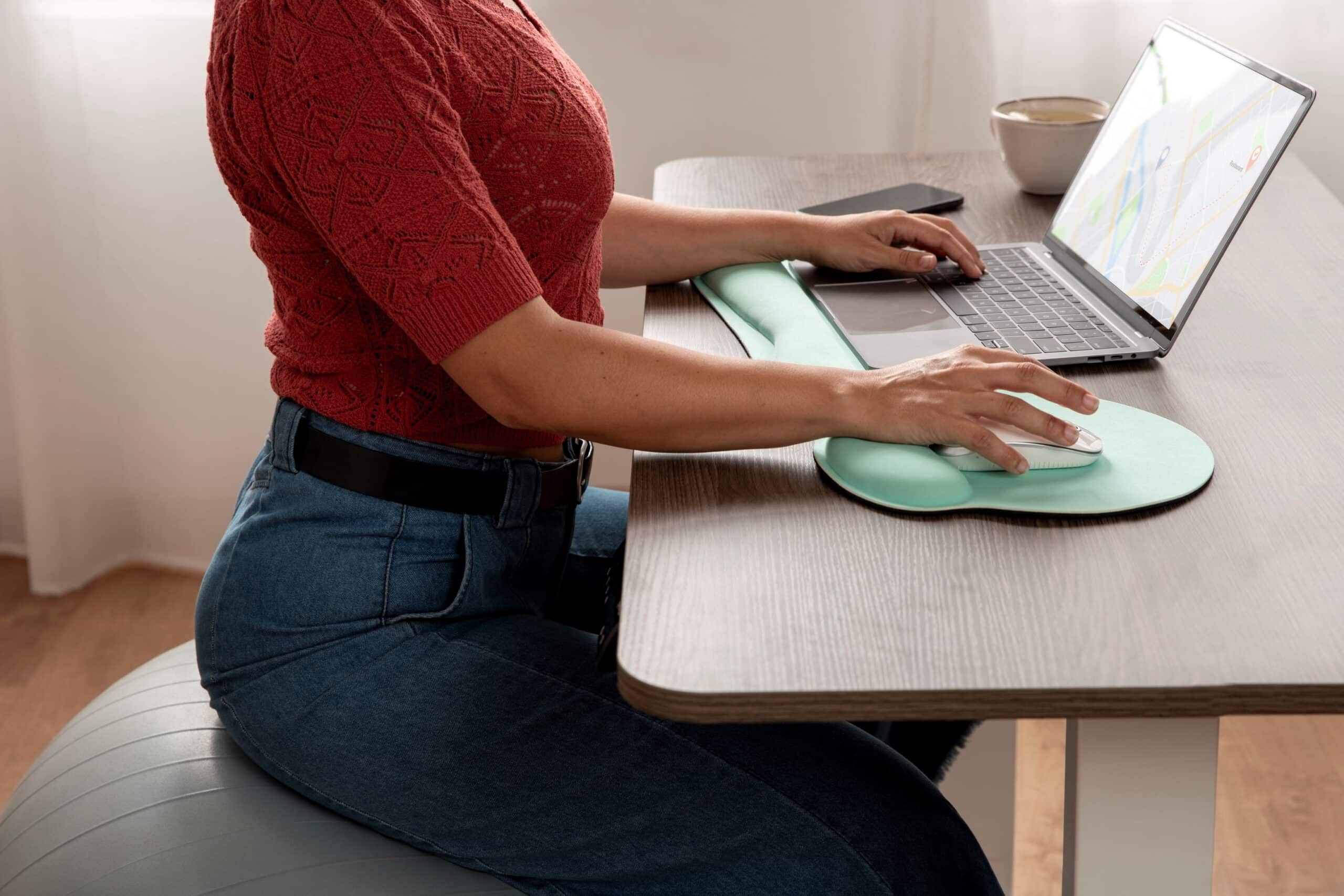By Farhan Malik, MD
Atlanta Innovative Medicine
Many of us spend hours working in front of screens, whether at the office or from home, and it often comes with an unwelcome consequence: back pain from sitting at a desk. Although we may not be able to completely change our work environments, we can control how much these habits impact our health. By understanding the causes of desk-related back discomfort and adopting simple ergonomic practices, we can promote a healthier, pain-free back.
This article will explore the common causes of back pain from sitting at a desk, including poor posture, prolonged sitting periods, and a lack of movement, and share ergonomic tips, stretches, and daily habits that can help reduce pain and improve spine health.
If back pain from sitting at a desk all day is affecting your day-to-day, don’t wait—book your consultation with AIM today, and take the first step toward a healthier, pain-free back!
The Impact of Desk and Work-from-Home Jobs on Back Pain
Remote work and desk jobs have become increasingly common, and they often involve prolonged periods of sitting. This sedentary lifestyle can lead to muscle strain, spinal misalignment, and, over time, chronic back pain. According to recent studies, individuals who sit for more than six hours daily are at a higher risk of developing back issues.

How Sitting Impacts Your Spine and Muscles
Sitting for extended periods puts pressure on your lumbar spine and weakens supporting muscles. Poor posture—such as slouching or leaning forward—further strains your back, leading to discomfort and potential injury. Over time, this can cause chronic pain and contribute to conditions like herniated discs or sciatica, making even simple movements painful.
Signs That Your Posture Is Hurting Your Back
Recognizing the early signs that your posture may be harming your back is important for prevention. Persistent lower back pain, stiffness or soreness after sitting, numbness or tingling sensations, headaches stemming from neck tension, and a noticeable loss of flexibility or mobility can all indicate that your posture isn’t supporting your spine as well as it could. Paying attention to these warning signs allows you to make necessary adjustments before more serious issues develop.

Creating the Ideal Ergonomic Setup
You’ve probably heard the advice to “sit up straight” as a way to encourage good posture. However, “straight” isn’t quite the target—what we’re really aiming for is a neutral spine.
A neutral spine preserves your spine’s natural curves, reflecting the spine’s S-shaped curvature, with a gentle inward curve at the lower back (lumbar lordosis), a slight outward curve at the upper back (thoracic kyphosis), and a soft inward curve at the neck (cervical lordosis). In this posture, there’s no excessive slouching or arching, and the shoulders are comfortably relaxed back into their sockets, not rounded forward or scrunched up by your ears.
Maintaining this alignment helps distribute weight evenly across your spine, reducing strain on muscles and ligaments and promoting overall spinal health.

So, how can you maintain a neutral spine to prevent back pain from sitting at a desk? The key is to create an ergonomic workspace:
- Chair: Use a height-adjustable chair that supports the natural curve of your spine. This ensures your lower back is consistently supported throughout the day.
- Monitor: Position your monitor at eye level to prevent neck flexion and reduce strain on your cervical spine. Adjust the brightness and font size so you don’t have to lean forward or squint to see your screen.
- Keyboard and Mouse: Keep these at a height where your elbows remain close to your body and your shoulders stay comfortably away from your ears, allowing you to maintain a natural, relaxed arm position.
- Feet: Rest your feet flat on the floor or on a footrest to support proper posture from the ground up.
- Desk: Ensure there is enough space to sit comfortably with a relaxed posture, helping you avoid unnecessary strain and maintain a neutral spine.
By setting up your workspace this way, you’ll find it easier to maintain a neutral spine throughout the day without needing to work so hard at it.
Daily Habits to Prevent Back Pain and Promote Spinal Health
In addition to setting up an ergonomic workspace, adopting simple daily habits can go a long way in supporting your spinal health. Consider incorporating these practices into your routine:
- Take short breaks every 30-60 minutes to stand up, stretch, and move around.
- Maintain good posture, always aiming for a neutral spine while standing or sitting.
- Use a lumbar support pillow if needed to help support your lower back throughout the day.
- Incorporate walking or light physical activity into your routine—it’s a great way to refresh your mind, boost your productivity, and keep your muscles active.
- Stay well-hydrated to help keep your spinal discs healthy and flexible.
By incorporating these habits into your daily routine, you’ll strengthen your back muscles, improve your posture, and reduce the risk of developing chronic pain. Remember it’s about progress over perfection—small, consistent changes can make a major difference in supporting your spine’s health over time.


Subscribe for Expert Insights and Our Ebook
A Closer Look at Regenerative Medicine: Comparing Your Options Learn about treatment options like Platelet Rich Plasma (PRP), Prolozone Therapy, and Stem Cell Therapy.
Simple Stretches to Ease Discomfort and Improve Spinal Health
Stretching is a simple and effective way to relieve muscle tightness and back pain caused by sitting at a desk, as well as maintain spine flexibility. Here are some easy stretches you can incorporate into your day:
- Seated Spinal Twist: Sit upright in your chair, place one hand on your opposite knee, and gently twist your torso. This stretch helps release tension in your back muscles.
- Hip Flexor Stretch: Kneel on one leg, place the other in front of you in a lunge position. Push your hips forward, and feel the stretch in the front of your thigh. It’s a great way to loosen up tight hip muscles that can affect your lower back.
- Hamstring Stretch: While sitting, extend one leg out in front of you and reach toward your toes. Keeping your hamstrings flexible can reduce strain on your lower back.
- Cat-Cow Pose: On your hands and knees, alternate arching your back (cow) and rounding it (cat). This gentle movement keeps your spine mobile and relieves stiffness.
Adding these stretches to your daily routine can make a noticeable difference in how comfortable you feel and help maintain healthy spinal function.
Bonus Exercise for Strength and Flexibility: Ball to Bridge
To further support your back by building core strength and encourage spinal flexibility, consider adding this exercise to your routine, too (always check with your doctor before starting new exercises):
Ball to Bridge:
- Lie on your back and gently squeeze your knees toward your chest, allowing your spine and neck to flex slightly and curl into a ball. Hold for a count of three.
- Next, release your legs and head, placing your feet hip-width apart on the ground, and return to a neutral spine with your head and shoulders resting comfortably on the floor.
- From this position, lift your hips into a glute bridge, engaging your core and glutes. Hold for a count of three, then slowly lower your hips back down and curl back into the ball position.
- Repeat this movement, flowing from ball to bridge, to help develop both flexibility and strength in your lower back, hips, and glutes.
Standing vs. Sitting: Finding the Right Balance
While sitting is often unavoidable, it’s important to keep moving—your back will thank you. The goal is to balance periods of sitting with standing and movement throughout the day:
- If possible, use a sit-stand desk that allows you to alternate between sitting and standing. Aim to switch positions every 30-45 minutes, so you’re not staying in one spot for too long.
- Take regular walks, even if it’s just around your home or office, to keep your muscles active and your circulation flowing.
Remember, finding the right balance of sitting, standing, and moving helps keep your spine happy and healthy—and can even boost your energy and focus while you work. Small changes like these can add up to big improvements over time.

When to See a Specialist
What if, even after making ergonomic changes and incorporating spine-supporting habits into your daily routine, your back pain persists? It’s time to bring in the experts. If your discomfort persists despite adjustments or if you’re experiencing symptoms such as numbness, weakness, or issues with bladder control, don’t wait—schedule a consultation with AIM’s team of specialists. Conditions like sciatic nerve problems often require targeted evaluation and treatment.
Treating Back Pain at AIM
At Atlanta Innovative Medicine, we take a personalized approach to back pain. We begin with a thorough diagnosis, utilizing tests such as nerve conduction studies, X-rays, MRIs, and detailed pain assessments to identify the underlying cause.
Once diagnosed, we offer tailored, non-surgical treatments—including support options like braces and orthotics, as well as innovations like sarapin injections, chiropractic care, and physical therapy. We also specialize in regenerative medicine, using techniques such as PRP, prolozone therapy, prolotherapy, and stem cell therapy to promote tissue repair and reduce inflammation. These treatments aim to provide long-lasting relief by targeting the source of pain, even when the causes are complex and multifaceted.
If back pain from sitting at a desk persists and you’re seeking relief, please contact our team today!

Don’t Let Back Pain Hold You Back
By now, you should understand the common culprits behind back pain caused by sitting at a desk: poor posture, prolonged periods of inactivity, and a lack of physical movement. You’ve also got practical tips to help address these issues, and you know when it’s time to seek professional help.
Healing doesn’t have to be invasive or risky. At Atlanta Innovative Medicine, our goal is to provide safe, effective, and natural treatments that target the root cause of your back pain and support real recovery. If you’re tired of living with discomfort, we encourage you to try the tips and habits outlined in this article. And if your pain persists, don’t hesitate to reach out—schedule a consultation with us and take the first step toward a healthier, pain-free back!
Quizzes
Are you a candidate for Regenerative Medicine?
Regenerative medicine can be an effective therapy and treatment option for lasting pain relief for a variety of conditions like osteoarthritis of the knee, hip or shoulder; ACL or meniscus tears; tennis or golfer’s elbow; chronic neck and back pain; and more.
Is it right for you and your condition? Take 1 minute to answer a few “yes or no” questions that help to assess if you might be a candidate for PRP, stem cell or other nonsurgical regenerative treatments.
Are You a Stem Cell Candidate for Your Joint or Spine Damage?
Are you a candidate for Platelet Rich Plasma (PRP) Therapy?
Do I have nonsurgical options for my injured or aging joints?
Take the Pain Medications Risk Quiz

Regenerative Medicine.
Reimagined
- Advanced hybrid therapies, including Mesenchymal Stem Cell therapy combined with different mechanisms of action that synergistically come together to support ultimate healing
- More powerful PRP that’s customized, amplified and personalized
- Therapies delivered by an experienced, compassionate team comprised of multidisciplinary experts in traditional and alternative medicine working as your team: Medical Doctors, Nurse Practitioners, Physiotherapists and Chiropractors
- Advanced training through the American Academy of Orthopedic Medicine, the American Osteopathic Association of Prolotherapy Regenerative Medicine, and more
All content of this page is for informational purposes only and is not intended to serve as a substitute for the consultation, diagnosis, and/or medical treatment of a qualified physician or healthcare provider. Individual results may vary. Your medical professional can explain all the risks and potential benefits of any therapy based on your specific circumstances. At this time regenerative therapies are not FDA approved. Neither Atlanta Innovative Medicine nor its physician affiliates promise regenerative therapies as a cure for any condition, disease, or injury.
Other Atlanta Areas We Service:
© 2024 Atlanta Innovative Medicine, LLC. All Rights Reserved. AIM Scholarship Opportunity








